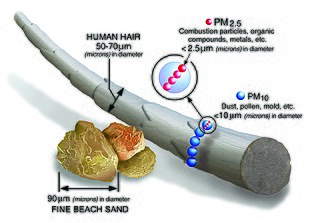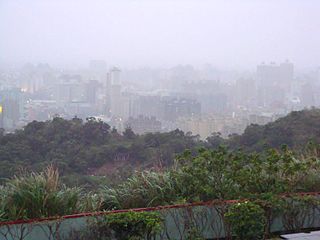Related Research Articles

Smog, or smoke fog, is a type of intense air pollution. The word "smog" was coined in the early 20th century, and is a portmanteau of the words smoke and fog to refer to smoky fog due to its opacity, and odor. The word was then intended to refer to what was sometimes known as pea soup fog, a familiar and serious problem in London from the 19th century to the mid-20th century, where it was commonly known as a London particular or London fog. This kind of visible air pollution is composed of nitrogen oxides, sulfur oxide, ozone, smoke and other particulates. Man-made smog is derived from coal combustion emissions, vehicular emissions, industrial emissions, forest and agricultural fires and photochemical reactions of these emissions.

Asian Dust is a meteorological phenomenon that affects much of East Asia year-round and especially during the spring months. The dust originates in the deserts of China, Mongolia, and Kazakhstan, where high-speed surface winds and intense dust storms kick up dense clouds of fine, dry soil particles. These clouds are then carried eastward by prevailing winds and pass over China, North and South Korea, and Japan, as well as parts of the Russian Far East. Sometimes, the airborne particulates are carried much further, in significant concentrations which affect air quality as far east as the United States.

Pollution in China is one aspect of the broader topic of environmental issues in China. Various forms of pollution have increased following the industrialisation of China, causing widespread environmental and health problems.

Air pollution in Hong Kong is considered a serious problem. In 2004, visibility was less than eight kilometers for 30 per cent of the year. Cases of asthma and bronchial infections have soared due to reduced air quality. However, in recent years, the hours of reduced visibility in Hong Kong have decreased by significant amounts compared to the previous ten years.

Air pollution is the contamination of air due to the presence of substances called pollutants in the atmosphere that are harmful to the health of humans and other living beings, or cause damage to the climate or to materials. It is also the contamination of the indoor or outdoor environment either by chemical, physical, or biological agents that alters the natural features of the atmosphere. There are many different types of air pollutants, such as gases, particulates and biological molecules. Air pollution can cause diseases, allergies, and even death to humans; it can also cause harm to other living organisms such as animals and crops, and may damage the natural environment or built environment. Air pollution can be caused by both human activities and natural phenomena.
Air pollution is the introduction of chemicals, particulate matter, or biological materials into the atmosphere that cause harm or discomfort to humans or other living organisms, or damage ecosystems. Health problems attributed to air pollution include premature death, cancer, organ failure, infections, behavioral changes, and other diseases. These health effects are not equally distributed across the U.S. population; there are demographic disparities by race, ethnicity, socioeconomic status, and education. Air pollution can derive from natural sources, such as wildfires and volcanoes, or from anthropogenic sources. Anthropogenic air pollution has affected the United States since the beginning of the Industrial Revolution.

Pollution in California relates to the degree of pollution in the air, water, and land of the U.S. state of California. Pollution is defined as the addition of any substance or any form of energy to the environment at a faster rate than it can be dispersed, diluted, decomposed, recycled, or stored in some harmless form. The combination of three main factors is the cause of notable unhealthy levels of air pollution in California: the activities of over 39 million people, a mountainous terrain that traps pollution, and a warm climate that helps form ozone and other pollutants. Eight of the ten cities in the US with the highest year-round concentration of particulate matter between 2013 and 2015 were in California, and seven out of the ten cities in the US with the worst ozone pollution were also in California. Studies show that pollutants prevalent in California are linked to several health issues, including asthma, lung cancer, birth complications, and premature death. In 2016, Bakersfield, California recorded the highest level of airborne pollutants of any city in the United States.

Air Pollution in Mexico City has been of concern to the city's population and health officials for decades. In the 20th century, Mexico City's population rapidly increased as industrialization brought thousands of migrants from all over the world. Such a rapid and unexpected growth led to the UN declaring Mexico City as the most polluted city in the world in 1992. This was partly due to Mexico City's high altitude, which causes its oxygen levels to be 25% lower. Carbon-based fuels also do not combust completely. Other factors include the proliferation of vehicles, rapid industrial growth, and the population boom. The Mexican government has several active plans to reduce emission levels which require citizen participation, vehicular restrictions, increase of green areas, and expanded bicycle accessibility.

Particulates or atmospheric particulate matter are microscopic particles of solid or liquid matter suspended in the air. The term aerosol refers to the particulate/air mixture, as opposed to the particulate matter alone, though it is sometimes defined as a subset of aerosol terminology. Sources of particulate matter can be natural or anthropogenic. They have impacts on climate and precipitation that adversely affect human health, in ways additional to direct inhalation.

The 2013 Eastern China smog was a severe air pollution episode that affected East China, including all or parts of the municipalities of Shanghai and Tianjin, and the provinces of Hebei, Shandong, Jiangsu, Anhui, Henan, and Zhejiang, during December 2013. A lack of cold air flow, combined with slow-moving air masses carrying industrial emissions, collected airborne pollutants to form a thick layer of smog over the region. Levels of PM2.5 particulate matter averaged over 150 micrograms per cubic metre; in some areas, they were 300 to 500 micrograms per cubic metre.

In Turkey, air pollution is the most lethal of the nation's environmental issues, with almost everyone across the country exposed to more than World Health Organization guidelines. Over 30,000 people die each year from air pollution-related illnesses; over 8% of the country's deaths. Air pollution is particularly damaging to children's health. Researchers estimate that reducing air pollution to World Health Organization limits would save seven times the number of lives that were lost in traffic accidents in 2017.

The air quality in Delhi, the capital territory of India, according to a WHO survey of 1,650 world cities, and a survey of 7,000 world cities by the US-based Health Effects Institute in August 2022, is the worst of any major city in the world. It also affects the districts around Delhi. Air pollution in India is estimated to kill about 2 million people every year; it is the fifth largest killer in India. India has the world's highest death rate from chronic respiratory diseases and asthma, according to the WHO. In Delhi, poor quality air irreversibly damages the lungs of 2.2 million or 50 percent of all children.

The 2016 Southeast Asian Haze was a transnational haze crisis which is a recurring problem with transboundary air pollution brought on by fires. The 2016 haze that took place affected several countries in Southeast Asia, including Indonesia, Malaysia and Singapore. It brought negative effects towards the environment and brought an impact on people's health and the economy.

Air pollution in Taiwan is mostly derived from sources of domestic combustion, primarily the burning of fossil fuels. Taiwan's topography has been noted to be a contributing factor to its air pollution problem, leading to poor dispersal and trapping pollutants. Taipei, Taiwan's capital and largest city for example, is surrounded by mountains, and other industrial centers along the northern and western coasts of Taiwan are surrounded by high mountains.
Fugitive dust is an environmental air quality term for very small particles suspended in the air, primarily mineral dust that is sourced from the soil of Earth's pedosphere. A significant volume of fugitive dust that is visible from a distance is known as a dust cloud, and a large dust cloud driven by a gust front is known as a dust storm.

Air pollution in South Korea is an increasing threat to people and the environment. The air pollution comes from many sources, both domestic and international. Many forms of pollution have increased in South Korea since its rapid industrialization, especially in Seoul and other cities. According to the U.S. National Aeronautics and Space Administration (NASA), Seoul is one of the world's cities with the worst air pollution. From 2009 and 2013, the city's mean PM10 were higher than in many of the largest metropolitan cities in the world such as: Los Angeles, Tokyo, Paris, and London. This has resulted in health and environmental problems. Koreans buy masks and air purifiers to breathe cleaner air, and are working to reduce the country's emissions.

Air quality in Utah is often some of the worst in the United States. Poor air quality in Utah is due to the mountainous topography which can cause pollutants to build up near the surface combined with the prevalence of emissions from gasoline- and diesel-powered vehicles, especially older models. Burning wood fuel for home heating can also contribute significantly to poor air quality. Homes heated with wood contribute about 3000 times the amount of pollution as homes heated with natural gas. About 50% of air pollution in Salt Lake County is from vehicles.
Non-exhaust emissions come from wearing down motor vehicle brake pads, tires, roads themselves, and unsettling of particles on the road. This particulate matter is made up of micrometre-sized particles and causes negative health effects, including respiratory disease and cancer. Very fine particulate matter has been linked to cardiovascular disease. Multiple epidemiological studies have demonstrated that particulate matter exposure is associated with acute respiratory infections, lung cancer, and chronic respiratory and cardiovascular disease. Researchers have also found correlations between exposure to fine particulate matter and fatality rates in previous coronavirus epidemics.
Particulate pollution is pollution of an environment that consists of particles suspended in some medium. There are three primary forms: atmospheric particulate matter, marine debris, and space debris. Some particles are released directly from a specific source, while others form in chemical reactions in the atmosphere. Particulate pollution can be derived from either natural sources or anthropogenic processes.
Karachi is the largest city in Pakistan and the 12th largest city in the world is facing a significant air pollution problem. The air quality of Karachi has been deteriorating over the years, with pollution levels often exceeding safe limits set by the World Health Organization (WHO).
References
- 1 2 "Rise in air pollution causing respiratory illnesses in Islamabad". The Nation. December 3, 2022.
- 1 2 "Increasing pollution causing surge in respiratory illness among residents". The Nation. December 1, 2022.
- ↑ "Air quality worsens in twin cities". The Express Tribune. October 18, 2022.
- ↑ "'Air quality in Islamabad declared healthy'". www.geo.tv.
- ↑ "Capital breathes healthy air after months in Islamabad". The Express Tribune. February 3, 2021.
- ↑ "Air pollution high in capital amid soaring heat, vehicular emissions". June 16, 2022.